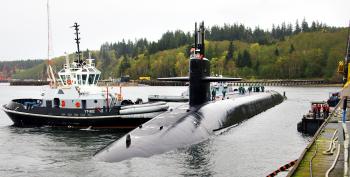
The Ohio-class ballistic missile submarine USS Louisiana (SSBN 743) prepares to moor at Naval Base Kitsap-Bangor following a strategic deterrent patrol on April 5, 2013.
U.S. Navy photo by Lt. Ed Early

Chef Tenney Flynn, co-owner of the New Orleans seafood restaurant GW Fins, offers some cooking pointers to Culinary Specialist 2nd Class Larry Risher, assigned to the Blue Crew of the ballistic missile submarine USS Louisiana (SSBN 743). Flynn helped the boat’s culinary specialists make some of GW Fins’ popular dishes for Louisiana’s crew while he was visiting on Sept. 28, 2012.
U.S. Navy photo by Lt. Ed Early

Sailors assigned to the Blue crew of the ballistic missile submarine USS Louisiana (SSBN 743) moor the boat as it returns home to Naval Base Kitsap-Bangor following a strategic deterrent patrol on April 22.
U.S. Navy photo by Chief Mass Communication Specialist Ahron Arendes
Proud, powerful USS Louisiana completes milestone
BANGOR, Wash. — Hidden somewhere deep in the Pacific Ocean a vessel with Louisiana flair is ready to strike at any moment should the need arise.
The USS Louisiana (SSBN 743) is a ballistic missile submarine that goes to sea and stays on call in case the commander in chief decides to conduct a nuclear strike, USS Louisiana Commanding Officer Capt. Kevin Byrne said. Each patrol lasts about three months and then switches crews, Byrne said. The Louisiana’s homeport is in Bangor, Wash.
The submarine just returned to port last week, Byrne said.
Byrne began serving on the USS Louisiana in late January and went on patrol shortly after that, he said. Byrne was previously the captain of the USS Alaska from 2009 to 2012.
The last patrol the ship did was its 50th patrol, which is a major milestone, Byrne said. “We generally stay in the Pacific. We don’t disclose the actual locations. We generally go out and disappear in large chunks of water,” Byrne said. “No one really knows where we are. We don’t report our position to anybody. We check in periodically, but part of our mission is to stay stealthy and go where we need to — to make sure nobody knows where we’re at,” Byrne said.
The USS Louisiana is capable of carrying 24 trident missiles, Byrne said.
The USS Louisiana was commissioned in 1997 and is the newest of the 14 Trident-class submarines in the U.S. Navy, Byrne said. The boat also has torpedoes for self-defense.
Since Sept. 11, 2001, the security requirements for the ballistic missile fleet has gone up so the submarine generally pulls in and out of the home port but mostly stays out of foreign ports, Byrne said.
“The ship itself has really got the ability to be its own self-serving city,” Byrne said. The submarine produces its own water, power, oxygen and brings food on board, he said. “We really have no reason to come up to the surface for anything,” Byrne said.
The ship’s sonar systems allow it to detect anything coming near it, Byrne said. “If we need to drive away, we detect them long before we’re found,” Byrne said. “We’re pretty good at staying hidden and going places undetected.”
A lot of the decorations throughout ship are Louisiana-themed, he said. The four meals served each day are also Louisiana-themed, Byrne said. The crew has adopted the “who dat” and “we dat” slogans when crew members are training, he said.
“The crew has really embraced the whole Louisiana culture even though not many of us have ties to the great state of Louisiana,” Byrne said.
Crew members also do home state visits where they visit Louisiana, he said. The vessel used to be stationed in Kings Bay, Ga.
USS Louisiana Weapons Department Advisor and Senior Chief Petty Officer George Hammond, who is originally from Hammond, is one of four crew members on the vessel from Louisiana, he said. A total of 154 crew members serve on the USS Louisiana. Hammond has been in the Navy for 19 years and two years on the USS Louisiana.
Hammond’s parents have visited him and toured the boat, he said. Hammond oversees four divisions including the sonar division, torpedoing, fire control technicians and missile technicians.
A typical day for the crew consists of three six-hour watches, Byrne said. One crew member will eat breakfast from 5 a.m. to 6 a.m. and will then stand watch until noon followed by another meal.
“Then the next six hours, he generally will use to do his day job maybe some training, maybe we’ll run some drills,” Byrne said. At 6 p.m. the third meal of the day is served, and the same crew member would sleep from 6 p.m. to midnight going back on watch after that, Byrne said.
Training exercises vary from day to day, and the ship may run engineering drills one morning and run a simulated torpedo attack in the afternoon, Byrne said.
Crew members take time to rest and relax on Saturdays and Sundays, but also take about four to five hours to clean the ship, Byrne said.
“We do a lot of training. We run a lot of drills. We kind of put ourselves in simulated wartime environments so that we can practice how we would operate the ship if it ever came to task that we were called to do the real thing,” Byrne said.
- Log in to post comments
